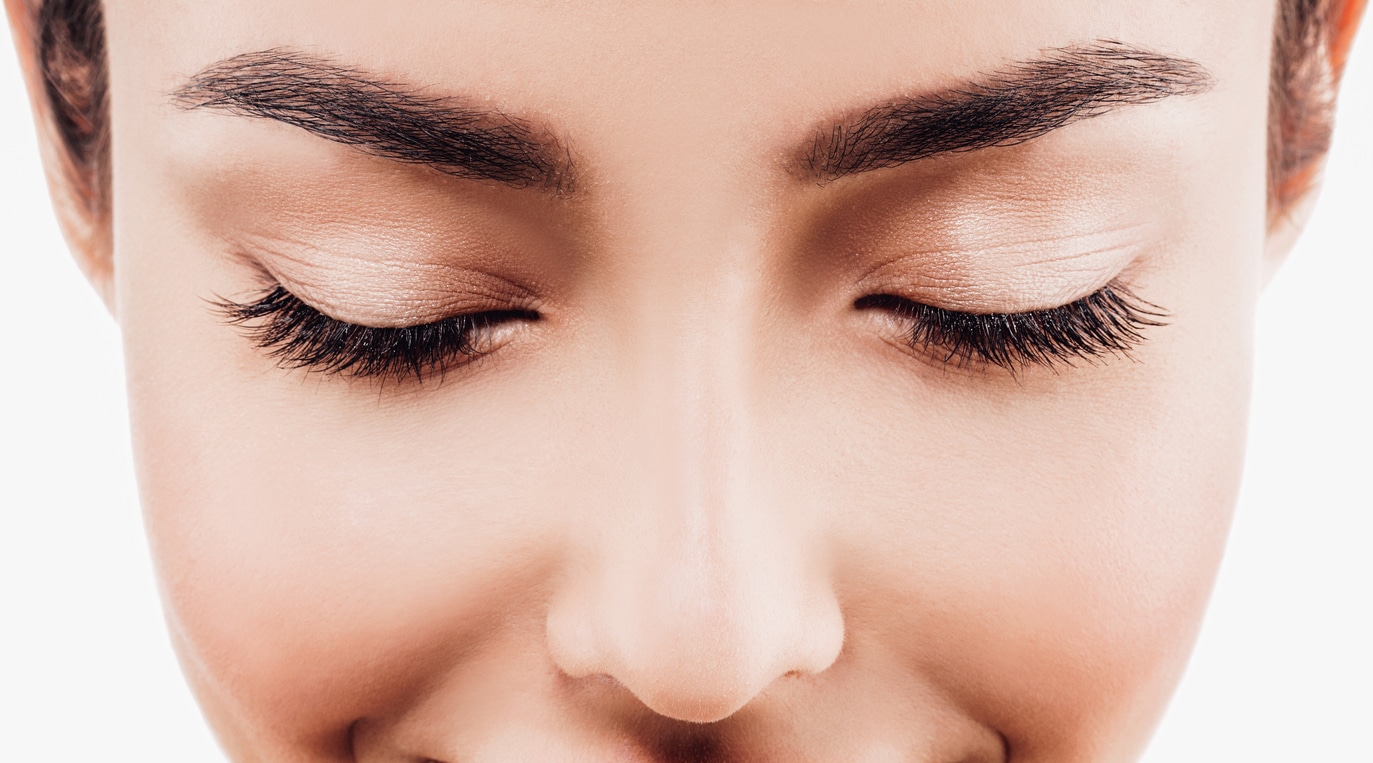Rhinoplasty surgery changes the size, shape, and structure of your nose. Commonly called a nose job, this popular facial plastic surgery procedure can reduce a prominent bump, narrow a wide tip, straighten a crooked bridge, fix asymmetry, or make your nose more proportional to the rest of your facial features.
Refine your profile and breathe new life into your appearance with the distinguished expertise at The Larrabee Center in Seattle, Washington. Dr. Kurian and Dr. Larrabee, a team of board-certified facial plastic surgeons, are masters of transformation, specializing in rhinoplasty that harmonizes your natural beauty with meticulous precision.
Explore a new horizon of confidence with our tailored rhinoplasty procedures. Whether for cosmetic enhancement or functional improvement, rhinoplasty at The Larrabee Center is a blend of science and sculpture, meticulously executed to complement the delicate balance of facial features.
What is a Rhinoplasty?

Rhinoplasty, the clinical term for nose surgery, can change your nose, removing imperfections or simply making it more proportional to the rest of the face.
Rhinoplasty is one of the original cosmetic surgeries, first performed in the United States in 1887. The surgery involves making incisions to access the underlying bone and cartilage.
Depending on the patient’s goals, Dr. Larrabee may remove some bone and cartilage, or tissue may be added. Once he has altered the underlying structure of the nose, the skin, and tissue are re-draped over the new structure.
Nose surgery is a delicate procedure, and Dr. Larrabee takes great pride in his ability to give his patients the nose they feel confident, comfortable, and happy with. This procedure can really change a patient’s self-image.
Rhinoplasty is a surgical procedure that involves reshaping or correcting the nose for aesthetic or functional purposes. It offers a solution for individuals seeking to enhance their facial harmony or rectify an imbalance. It addresses concerns from adjusting nose size to facial balance, altering the width of the bridge, to reshaping the nasal tip or nostrils.
Additionally, rhinoplasty can be performed to correct impaired breathing caused by structural abnormalities in the nose, such as a deviated septum. Primarily known for its cosmetic outcomes, it combines visual refinement and functional restoration.
How Does Rhinoplasty Work?
Rhinoplasty is a surgical procedure that involves carefully altering the nasal bones and cartilage to enhance the nose’s shape, size, and overall contour. During the surgery, an incision is usually made inside the nostrils or across the columella (the strip of tissue separating the nostrils) to minimize visible scarring.
In some cases, cartilage grafts taken from other parts of the body, like the ears or the rib, can be used to support or augment the nasal structure. Additionally, for functional improvements such as correcting a deviated septum and allowing for better airflow, adjustments are made to the nasal septum, which is the partition between the two sides of the nose.
Rhinoplasty requires a combination of surgical skill and artistic sensibility to achieve results that are aesthetically pleasing and harmonious with the other facial features of the patient.
Benefits of Rhinoplasty
From correcting asymmetries to improving breathing difficulties, Rhinoplasty can yield multifaceted benefits. For individuals self-conscious about their nasal appearance, it provides a sculpted nose that harmonizes with their facial features, often leading to heightened self-esteem and social well-being.
Beyond aesthetics, rhinoplasty addresses functional issues such as a deviated septum, enhancing airway flow, and making breathing more comfortable. This could result in better sleep, reduced snoring, and even relief from chronic sinusitis.
Why Choose Rhinoplasty?
Rhinoplasty is not just a cosmetic surgery to improve the appearance of one’s face. It can also significantly enhance the quality of life. Opting for rhinoplasty can rectify breathing issues, correct congenital defects, and repair damage from previous injuries.
It’s a procedure that can transform a person’s appearance, boost self-confidence, and align their outer appearance with their inner self. Thanks to advancements in medical techniques, rhinoplasty has become safer and more accessible, providing personalized and natural-looking results.
When Will the Results Show?
The full results of a rhinoplasty can take some time to become visible due to the natural swelling that occurs after the surgery. Typically, you can expect the initial swelling to subside within a few weeks, but it’s not uncommon for subtle swelling to last longer. Waiting up to a year is generally advised for the most complete and final results. The healing process is gradual, but the outcome is worth the wait.
What areas can Rhinoplasty Treat?
For individuals self-conscious about the profile of their nose, rhinoplasty can rectify problems associated with the nasal bridge, including smoothing out humps and filling in depressions. Or improving symmetry.
Beyond aesthetics, rhinoplasty relieves those suffering from breathing difficulties due to nasal obstructions or a deviated septum, improving nasal airflow and overall respiratory function. This intricate procedure, therefore, caters to both the enhancement of the nose’s shape and the improvement of its essential functions.
Before, During, and After
What To Expect Before a Rhinoplasty Procedure
Before undergoing rhinoplasty, a preliminary consultation with a surgical nurse is required. Your overall health and age may necessitate a thorough medical assessment. It is vital to discontinue smoking and to avoid aspirin, anti-inflammatory medications, and certain herbal supplements due to their potential to induce bleeding and bruising. Detailed preoperative directions will be issued to you.
What To Expect During a Rhinoplasty Procedure
For surgery, a general anesthetic is typically utilized. Rhinoplasty can be performed using either a closed or open method—the former involves incisions within the nostrils and the latter requires a small cut across the columella, the narrow strip of tissue that separates the nostrils.
The bone and cartilage are reshaped underneath and additional cartilage grafts may be necessary to add structure. Any misalignment, such as a deviated septum, is simultaneously corrected, aiding in breathing function. The skin is meticulously redraped over the newly refined framework and sutured into place. For individuals seeking more petite nostrils, further alterations can be made along the natural folds of the nose.
What To Expect After a Rhinoplasty Procedure
Following your rhinoplasty procedure, you can expect that special care will be taken to support the delicate work performed. Immediately after, to aid in the healing process and to shield the newly adjusted nasal structures, a splint or bandages may be secured externally, and sometimes, packing is gently placed inside the nostrils.
The swelling that initially envelops your nose will start to dissipate, revealing the contours of your newly sculpted profile. However, the true metamorphosis unfolds over a year, during which you’ll observe subtle shifts in the structure of your nose as it elegantly refines to its final form.
It’s not uncommon to experience fluctuations in swelling, often more pronounced upon waking, throughout the first year post-surgery. This is a natural aspect of the healing journey and should gradually lessen as you approach the culmination of your rhinoplasty’s transformative.
Frequently Asked Questions
Who is a good candidate for rhinoplasty?
When a patient comes to the Larrabee Center exploring the possibility of nose surgery, there are usually three areas of dissatisfaction: cosmetic issues, injury repair, or improved function.
Cosmetic – If a person feels her nose is too bulbous or there’s a bump on the bridge, it can be a real issue. Here are common aesthetic reasons patients seek to make some changes:
- There is a prominent bump on the bridge.
- The nose droops downward.
- The nostrils are overly flared.
- The nose isn’t proportional to the rest of the face.
- The nose is too big or too small.
- The nose has a bulbous tip.
- The nose is too wide or flat.
- The nose is crooked from a prior injury.
Injury – People often injure their noses, but don’t always opt to correct them. Things like touch football games or even simply bumping into an unseen wall in a dark room can alter the look and the function. Dr. Larrabee can correct both the appearance and the function.
Function – Some people are born with nasal passages that are too narrow. Restricted airflow can lead to snoring and even sleep apnea. Mouth breathing is typically due to congenital issues with the inner nose. Rhinoplasty can open constricted airways and vastly improve breathing function.
What are the risks of rhinoplasty?
There are the general risks that accompany any surgery: anesthesia reaction, infection, bleeding, poor wound healing, scarring, and changes in skin sensation. Specific to this procedure, the patient may have difficulty breathing, skin discoloration and continued swelling, possible perforation of the nasal septum, or unsatisfactory final results. With the extensive experience and board-certified credentials of Dr. Larrabee, any of these complications are exceedingly rare. But if further changes are needed, revision surgery may be necessary.
How do I prepare for nose surgery?

As with any surgery, you’ll need to stop taking any blood thinners, anti-inflammatories, aspirin, and most supplements for one week prior to your surgery with Dr. Larrabee. These can all lead to increased bleeding, which shows itself with more extensive bruising during your recovery.
If you smoke, you’ll need to stop for at least two weeks prior to and following your surgery because smoking constricts the blood vessels, and this can dramatically impede healing with this procedure.
Your real preparation should be for two facets of nose surgery: getting used to how to wear your eyeglasses and sleeping. You can’t have the weight of your frames sitting on your healing nose, so they will need to be taped above your nose. It’s good to practice this a bit before your surgery, especially if you wear glasses full-time. You’ll also need to plan your sleeping arrangements, as you’ll need to sleep on your back for at least two weeks.
What is the procedure for Rhinoplasty?
For nose surgery, Dr. Larrabee uses two methods: closed or open surgery. During your consultation, Dr. Larrabee will discuss which method he believes fits your needs, but this will be a joint decision.
In open rhinoplasty, an incision is made across the columella, the sliver of tissue between your nostrils. The soft tissue is then lifted upward and off the bone and cartilage. The open method completely exposes the underlying structure, making more dramatic modifications possible. Once the bone or cartilage has been reshaped, the soft tissue is then brought back down.
In closed rhinoplasty, Dr. Larrabee makes all the necessary incisions inside the nose. Obviously, this leaves no visible scarring, but it also can limit the extent of reshaping that can be done. If the patient seeks to build up an area of the nose, Dr. Larrabee can take cartilage or other material from the septum, the ears, a rib, or synthetic implants can be used. When the patient seeks to shrink the size of the nose, the nasal bones must be broken.
What will my recovery be like after rhinoplasty?
When your surgery is complete, Dr. Larrabee will have packed your nose and placed a splint over the outside. This splint will stay in place for about one week. We’ll provide a cold compress to help minimize swelling, but there will be swelling and bruising.
This is inevitable with the degree of tissue trauma involved in rhinoplasty. For the first week, it will be necessary to keep your head elevated as much as possible, even when sleeping. Of course, you can’t sleep on your stomach. Sleeping on your side isn’t a good idea, either, as it’s too easy to change your position enough to place pressure on your nose. The area around your eyes and nose will be bruised and swollen usually for 10-14 days.
You’ll need to avoid any clothing you pull over your head to minimize the possibility of bumping your healing nose. If you wear glasses, they will need to be taped to your forehead for up to seven weeks to keep any pressure off your nose.
Any strenuous exercise or heavy lifting that increases blood flow to the face needs to be strictly avoided for several weeks. Dr. Larrabee will discuss your restrictions at length with you, giving you a timeframe to return to your typical exercise and activity routines.
When can I expect to see the full results of my rhinoplasty?

Patience is a virtue when recovering from nose surgery. Swelling can linger and can return later in the day and at night for weeks. It can take up to six months for a patient to fully realize their new nose, although this schedule varies dramatically with individual patients’ healing rates.
But your patience will be rewarded – rhinoplasty is a very satisfying procedure, as patients who have always had issues with features of their nose feel as if their whole facial appearance has improved with their new nose.
Will Rhinoplasty change my breathing or nasal function?
If you’re undergoing rhinoplasty for cosmetic purposes, it’s essential to choose experienced board-certified surgeons like Dr. Kurian and Dr. Larrabee, who understand the complex structure of the nasal passages. The procedure should be done in such a way that it doesn’t obstruct your airways.
A well-performed rhinoplasty by a skilled surgeon should preserve or even improve breathing function if structural abnormalities that impede airflow are corrected during the process.
In some cases, individuals opt for septorhinoplasty, which combines the cosmetic enhancements of rhinoplasty with corrections to any internal obstructions, like a deviated septum, to improve nasal breathing.
How long does a Rhinoplasty procedure typically take?
Rhinoplasty duration varies, typically ranging between one to three hours, depending on the complexity of the surgery.
How much does Rhinoplasty cost?
The cost of rhinoplasty depends on the complexity of the operation and individual aesthetic objectives. However, our experienced team at The Larrabee Center in Seattle will guide you in selecting the optimal choice that aligns with your cosmetic aspirations.
Will Rhinoplasty leave visible scars?
Rhinoplasty can lead to some visible scarring; however, the extent of the visibility depends on the surgical technique used. The two primary rhinoplasty techniques are:
- Closed Rhinoplasty: This technique involves incisions made within the nostrils. Consequently, there are no visible scars on the outside of the nose. Any scarring that does occur is inside the nostrils and not seen.
- Open Rhinoplasty: A precise incision is carefully crafted along the columella—the slender section of skin dividing the nostrils—facilitating an open surgical method. This technique grants the surgeon direct observation and enhanced maneuverability for meticulously sculpting the nasal structure. The strategically positioned incision ensures the resulting scar is minimally noticeable.
Can Rhinoplasty correct a deviated septum?
Rhinoplasty can correct a deviated septum. This is often done through a specific surgical procedure known as septorhinoplasty, which combines cosmetic enhancements with the functional correction of the septum. Septoplasty is the part of the surgery that corrects the alignment of the nasal septum, straightening it to improve airflow and relieve breathing difficulties.
